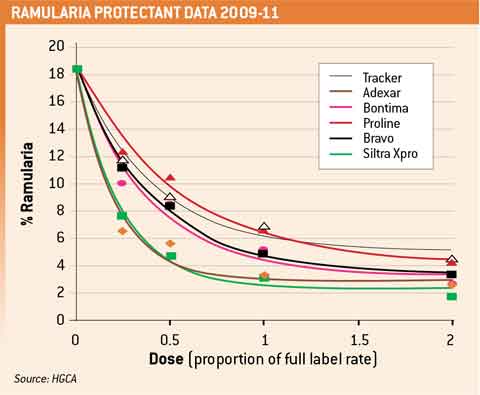SDHI chemistry promises good ramularia control

The SDHIs add useful efficacy on barley diseases and are likely to have an important role in protecting crops against ramularia in the future, says Stuart Knight, director of crops and agronomy at NIAB TAG.
“Ramularia is an emerging disease,” he explains. “And it’s pleasing to see that the SDHIs all have good activity against it. That matters because we do have some resistance in the disease to the strobilurins.”
The HGCA-funded fungicide performance data shows that Siltra Xpro (bixafen + prothioconazole)and newcomer Adexar (fluxapyroxad + epoxiconazole) are slightly stronger than Bontima (isopyrazam + cyprodinil) on ramularia, he adds.
“But they all perform well and are better on the disease than their triazole component alone,” he summarises. “So we’ve added to the armoury at a time when we needed to.”
Ramularia poses the greatest threat to spring barley, but also causes problems in winter barley, and can’t be controlled with seed treatments, advises Mr Knight.
“Fungicides need to be applied at booting, before the symptoms appear,” he continues. “The best approach seems to be a triazole/SDHI/chlorothalonil mix, but further work is on-going.”
The starting point with all barley fungicide comparisons is the current strength of the triazole prothioconazole, he stresses. “There are clear differences between the two key triazoles, with prothioconazole being the better of the two. So it’s been the standard in barley and it’s still performing well.”
Getting further data on the new fungicides in 2011 proved to be difficult at some sites, he says. “There was no brown rust in the HGCA trials sites and very little net blotch. So only rhynchosporium, powdery mildew and ramularia data was added.”
Starting with the 2011 rhynchosporium data, Bayer’s Siltra Xpro was the best in an eradicant situation, reports Mr Knight.
“It’s very good, especially at lower doses,” he notes. “After Siltra Xpro came Adexar, then Bontima.”
But in a protectant situation, Siltra Xpro and Adexar were very similar. “They lead the pack. Bontima gave a performance close to that of prothioconazole.”
Over three years, the gap between the top two narrowed. “Siltra Xpro and Adexar stand out in eradicant mode. Bontima comes into its own in a protectant situation, but doesn’t quite match the other two.”
The yield data reflected this performance, he reveals. “Siltra Xpro and Adexar took the top two positions.”

On net blotch, all three SDHIs did very well in eradicant mode over three years. “They are very active, as is prothioconazole.”
Mildew protection is a different story, notes Mr Knight. “There are some specific mildewicides already on the market that do a very good job. These include Talius (proquinazid), Torch Extra (spiroxamine) and Cyflamid (cyflufenamid).”
While the SDHIs in general have a bit of mildew activity, only Siltra Xpro gives a performance comparable with the mildewicides, he adds.
In summary, Mr Knight points out that Siltra Xpro and Adexar are closely matched all-rounders in barley, and that they are both more effective than their triazole component.
“Bontima is very active on net blotch, ramularia and brown rust.”
His final point is that the strobilurins are still active on rhynchosporium and rusts. “They still have a role in barley disease control programmes.”

